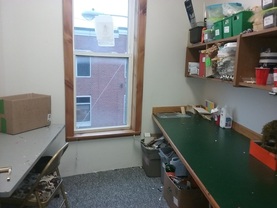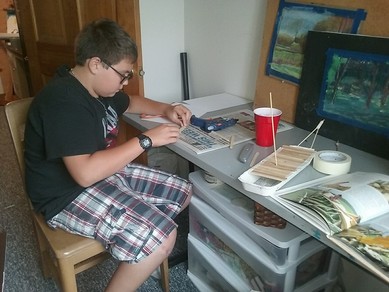 "clean" "clean" Last Friday I walked into the DRC project room and threw a wee bit of a conniption (no worries, the kids are not here on Friday). It looked like every cardboard box had been chewed into small bite size pieces, packing peanuts were strewn around like confetti, along with bits of paper, popsicle sticks, wooden skewers, paint brushes, tape, and all the other project materials that are readily available for the kids to use. My conclusion: we had either been hit by a small cyclone, or five kids had been struck by some serious inspiration over the past week and didn't clean up afterward. I am leaning towards the kids considering no one else reported damage from extreme weather in local neighborhoods. After my mini melt-down and cleaning spree (the recycling bin is now considerably fuller than it was last week), I took a mental step back to analyze why I was feeling upset. After all, I am the one who provided all of the supplies that went into that mess and I am a huge proponent of learning through a hands on, experiential process which always (at least in my case) involves some serious mess making. I finally pin-pointed the main reason for my distress, very few finished “things” were actually produced from all that creative flow, energy and resulting mess. As adults we generally focus on the tangible results of any project. “What did you make?” “What does it do?” “How does it work?”, are often questions we find ourselves asking a child when they proudly “show and tell” their personal creations. Very often children are flummoxed by our interrogations. “I just made it,” is usually the response, or in one particular case I get very detailed explanations about how such things as a cardboard tubes that have been wrapped like mummies in blue painters tape, work in his world. The child is obviously pure genius and gets more and more frustrated with my inability to understand what he is so desperately trying to explain. In my head, meanwhile, I am screaming, “but what in God's name is it?” For many kids the process (mess) of creating is enough. They don't need or even desire a finished product. They experimented, explored ideas, and learned what they needed to before moving on to the next process. I completely understand this concept from the intellectual and child-development perspective (see how nicely I am explaining it), but not on the visceral, and emotional level. I enjoy creating messes and I love to encourage others to make them too, but I hate (NO - really despise), the resulting disarray, disorder, and detritus which always brings on an overwhelming feeling of mental confusion and internal disquiet (I learned just last year that I am an ultra-sensitive person---good to know that I am not the only one and I that am not completely wacko!) How then do we balance these two essential components: the space, materials, and equipment for all of our processes and creativity, as well as an orderly, organized work environment (Maria's sanity)? My suggestion during our first Community meeting Monday morning, as always, was that we start with a conversation that includes observations, statements of need, lots of listening, and ultimately requests and compromise. Their plan so far includes placing a recycling bin in the project room, taking home all the finished projects, cleaning up supplies when they are finished, and dismantling any projects that they don't want to keep and put the components away if they are still usable. Like everything else around here --- this too will be a process of experimentation and exploration filled with heaps of opportunity for learning, for everyone, along the way.
0 Comments
Your comment will be posted after it is approved.
Leave a Reply. |
|
© 2024 Whole Learners, Inc. 501(c)3
Deep Root Center
48 Riverside Drive, Canton, NY 13617
315*323*1435/[email protected]
Deep Root Center
48 Riverside Drive, Canton, NY 13617
315*323*1435/[email protected]



